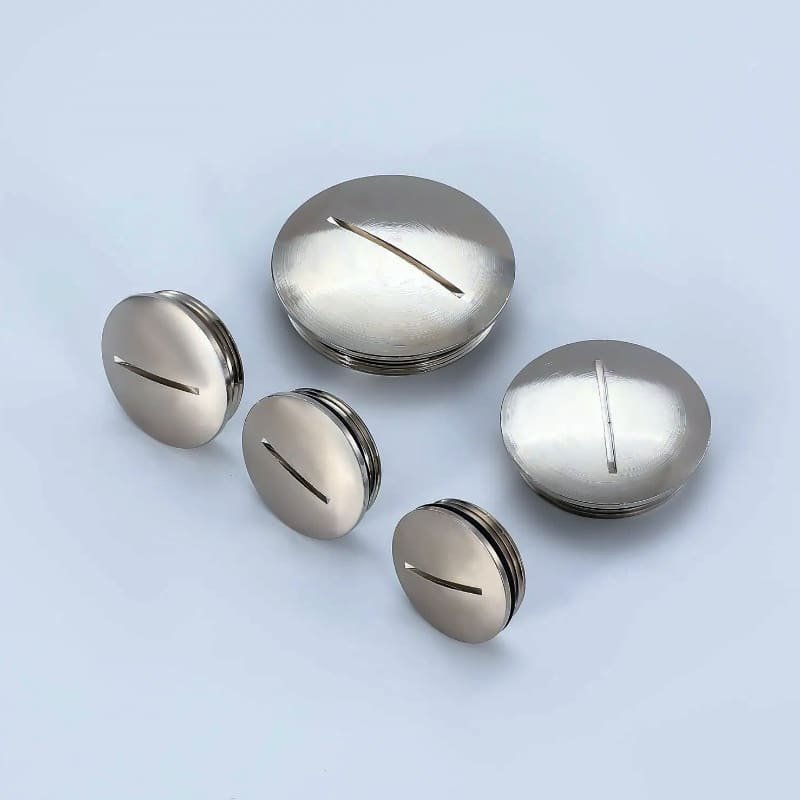In my 10+ years as Sales Director at Bepto Connector, I’ve seen countless engineers struggle with incomplete cable installations. You know that sinking feeling when you realize you have unused cable gland entries that need sealing? 😅
Stopper plugs are threaded sealing devices designed to close unused cable gland entries, maintaining IP ratings1 and preventing contamination in electrical enclosures. They’re essential components that work hand-in-hand with cable glands to ensure complete system integrity.
Just last month, David from a major automotive manufacturer in Detroit called me in a panic. His team had installed dozens of cable glands in their new production line, but several entries remained unused. Without proper sealing, their IP65-rated enclosures were compromised, risking expensive equipment damage from dust and moisture ingress.
Table of Contents
- What Are Stopper Plugs and Why Do You Need Them?
- How Do Stopper Plugs Work with Cable Glands?
- What Types of Stopper Plugs Are Available?
- How to Choose the Right Stopper Plug for Your Application?
- Installation Best Practices and Common Mistakes
- FAQs About Stopper Plugs
What Are Stopper Plugs and Why Do You Need Them?
Think of stopper plugs as the unsung heroes of electrical installations. While cable glands get all the attention for managing cable entries, stopper plugs quietly handle the equally important job of sealing unused openings.
Stopper plugs are threaded closure devices that screw into unused cable gland entries to maintain the enclosure’s IP rating and prevent environmental contamination. They’re not just simple caps – they’re engineered sealing solutions that must match the thread specifications and sealing requirements of your cable glands.
Why Every Installation Needs Stopper Plugs
In electrical enclosures, every opening is a potential failure point. Here’s why stopper plugs are non-negotiable:
Environmental Protection: Unused cable gland entries create direct pathways for dust, moisture, and contaminants to enter your enclosure. Even in indoor applications, temperature changes can create condensation that finds its way through unsealed openings.
IP Rating Compliance: If your enclosure is rated IP65 or higher, every unsealed opening compromises that rating. Insurance claims and warranty issues often arise from inadequate sealing practices.
Safety Requirements: In hazardous environments, unsealed entries can create explosion risks or allow dangerous gases to accumulate inside enclosures.
I remember Hassan, who runs a chemical processing facility in Saudi Arabia. He initially tried to save costs by leaving unused entries open, thinking the indoor location was safe enough. After a costly equipment failure caused by dust ingress, he learned that proper sealing isn’t optional – it’s essential for long-term reliability.
How Do Stopper Plugs Work with Cable Glands?
The relationship between stopper plugs and cable glands is beautifully simple yet critically important. Both components share the same threading system, creating a unified sealing approach for your enclosure.
Stopper plugs thread directly into unused cable gland mounting holes using the same metric or NPT threads2, creating a sealed closure that maintains the enclosure’s environmental protection rating.
Thread Compatibility System
Cable glands and stopper plugs use standardized threading systems:
| Thread Type | Common Sizes | Applications |
|---|---|---|
| Metric (M) | M12, M16, M20, M25, M32 | European standards, general industrial |
| NPT | 1/2″, 3/4″, 1″, 1-1/4″ | North American applications |
| PG | PG7, PG9, PG11, PG13.5, PG16 | Legacy German standard |
Sealing Mechanism
The sealing effectiveness comes from multiple components working together:
Primary Seal: The threaded engagement creates the first barrier against environmental ingress. The thread pitch and depth determine the seal’s mechanical strength.
Secondary Seal: Most quality stopper plugs include O-ring seals or gaskets that compress against the enclosure wall, creating a watertight barrier.
Material Compatibility: The plug material must be compatible with both the enclosure material and the operating environment to prevent galvanic corrosion3 or chemical degradation.
What Types of Stopper Plugs Are Available?
At Bepto, we manufacture stopper plugs in various materials to match different application requirements. The material choice significantly impacts performance, longevity, and cost-effectiveness.
The three main categories are nylon stopper plugs for general applications, brass plugs for high-temperature environments, and stainless steel plugs for corrosive conditions.
Nylon Stopper Plugs
Our most popular option offers excellent value for standard applications:
Advantages:
- Cost-effective for large installations
- Excellent chemical resistance to most industrial solvents
- Lightweight and easy to install
- Available in multiple colors for coding systems
- Temperature range: -40°C to +100°C
Best Applications: Indoor electrical panels, HVAC systems, general industrial equipment, telecommunications enclosures.
Brass Stopper Plugs
The premium choice for demanding environments:
Advantages:
- Superior mechanical strength
- Excellent thermal conductivity
- Natural antimicrobial properties
- Temperature range: -40°C to +200°C
- EMC shielding4 capabilities
Best Applications: High-temperature environments, marine applications, EMC-sensitive installations, heavy industrial equipment.
Stainless Steel Stopper Plugs
The ultimate solution for harsh conditions:
Advantages:
- Maximum corrosion resistance
- Suitable for food-grade applications
- Excellent mechanical properties at extreme temperatures
- Chemical resistance to acids and alkalis
- Temperature range: -200°C to +400°C
Best Applications: Chemical processing, offshore installations, food and pharmaceutical industries, extreme temperature environments.
How to Choose the Right Stopper Plug for Your Application?
Selecting the correct stopper plug involves more than just matching thread sizes. You need to consider environmental conditions, regulatory requirements, and long-term maintenance needs.
Choose stopper plugs based on thread compatibility, environmental conditions, temperature requirements, and chemical exposure, while ensuring the material matches your cable gland specifications.
Step-by-Step Selection Process
Step 1: Determine Thread Specifications
Measure your unused cable gland entries or check the installation drawings. Thread pitch is critical – M20x1.5 is different from M20x2.5, and using the wrong pitch will compromise the seal.
Step 2: Assess Environmental Conditions
Consider these factors:
- Operating temperature range
- Exposure to chemicals or solvents
- UV radiation (for outdoor applications)
- Vibration and mechanical stress
- IP rating requirements
Step 3: Material Selection Matrix
| Condition | Nylon | Brass | Stainless Steel |
|---|---|---|---|
| Standard indoor | ✅ Recommended | ✅ Good | ⚠️ Overkill |
| High temperature (>100°C) | ❌ Not suitable | ✅ Recommended | ✅ Best |
| Chemical exposure | ⚠️ Check compatibility | ⚠️ Limited | ✅ Recommended |
| Marine/offshore | ❌ Not suitable | ⚠️ Limited | ✅ Recommended |
| Food grade | ❌ Not suitable | ❌ Not suitable | ✅ Required |
Step 4: Consider Future Modifications
If you might need to add cables later, choose materials that won’t seize or corrode in the threads. Stainless steel plugs can be difficult to remove after years of service in some environments.
Common Selection Mistakes
I’ve seen these errors cost projects time and money:
Mixing Materials: Using brass plugs with aluminum enclosures creates galvanic corrosion. Always consider material compatibility.
Ignoring Temperature Cycling: Nylon plugs can become brittle in extreme cold or soften in high heat, leading to seal failure.
Overlooking Chemical Compatibility: Some cleaning solvents can attack nylon plugs, causing swelling or cracking.
Installation Best Practices and Common Mistakes
Proper installation is crucial for stopper plug performance. Even the highest-quality plug will fail if installed incorrectly.
Install stopper plugs with proper torque specifications5, ensure thread engagement depth, and verify seal compression while avoiding over-tightening that can damage threads or seals.
Installation Procedure
Preparation:
- Clean the threaded hole thoroughly
- Inspect threads for damage or debris
- Check the stopper plug for defects
- Apply thread sealant if specified (usually not required with O-ring seals)
Installation Steps:
- Start threading by hand to prevent cross-threading
- Tighten to finger-tight plus 1/4 to 1/2 turn with a wrench
- Verify the O-ring or gasket is properly compressed
- Check that the plug sits flush with the enclosure surface
Torque Specifications
| Thread Size | Nylon Plugs | Brass Plugs | Stainless Steel |
|---|---|---|---|
| M12 | 8-10 Nm | 12-15 Nm | 15-18 Nm |
| M16 | 12-15 Nm | 18-22 Nm | 22-25 Nm |
| M20 | 15-18 Nm | 22-28 Nm | 28-32 Nm |
| M25 | 18-22 Nm | 28-35 Nm | 35-40 Nm |
Common Installation Mistakes
Over-tightening: This is the most frequent error I see. Excessive torque can:
- Strip the threads in aluminum enclosures
- Crush O-ring seals
- Crack nylon plugs
- Make future removal difficult
Under-tightening: Insufficient torque leads to:
- Poor seal compression
- Vibration loosening
- IP rating compromise
Cross-threading: Starting the plug crooked damages both the plug and enclosure threads, requiring expensive repairs.
Conclusion
Stopper plugs might seem like simple components, but they play a vital role in maintaining the integrity of your electrical installations. The key is treating them as seriously as you treat cable glands – they’re part of the same sealing system.
Whether you choose nylon for cost-effectiveness, brass for high-temperature applications, or stainless steel for corrosive environments, proper selection and installation ensure long-term reliability. Remember David’s automotive plant? After implementing our complete stopper plug solution, they’ve had zero environmental ingress issues for over two years.
At Bepto, we manufacture stopper plugs to the same quality standards as our cable glands, with full certifications and technical support. Because when it comes to protecting your valuable equipment, every detail matters. 😉
FAQs About Stopper Plugs
Q: Can I use any stopper plug with any cable gland?
A: No, stopper plugs must match the exact thread specification of your cable gland entries. Using M20x1.5 plugs in M20x2.5 holes will not create a proper seal and may damage the threads.
Q: How do I know if my stopper plug is properly sealed?
A: A properly installed stopper plug should sit flush with the enclosure surface with the O-ring or gasket visibly compressed. You can perform a simple soap bubble test or use compressed air to verify the seal integrity.
Q: What’s the difference between stopper plugs and blanking plugs?
A: Stopper plugs are specifically designed for cable gland entries with O-ring seals and precise thread specifications. Blanking plugs are simpler closures for general holes and typically don’t provide the same level of environmental protection.
Q: Can stopper plugs be reused after removal?
A: High-quality stopper plugs with O-ring seals can typically be reused if the O-ring isn’t damaged and the threads are in good condition. However, we recommend replacing the O-ring for critical applications to ensure optimal sealing performance.
Q: Do I need thread sealant with stopper plugs?
A: Most quality stopper plugs with O-ring seals don’t require thread sealant, as the O-ring provides the primary seal. However, in vibration-prone applications, a small amount of thread locker can prevent loosening without compromising the seal.
-
Learn more about the official Ingress Protection (IP) rating system and what each digit signifies for environmental sealing. ↩
-
Explore a detailed comparison of Metric and National Pipe Thread (NPT) standards, including their specifications and common applications. ↩
-
Understand the electrochemical process of galvanic corrosion that occurs when different metals are in contact in the presence of an electrolyte. ↩
-
Discover the principles of Electromagnetic Compatibility (EMC) shielding and how it protects sensitive electronic components from interference. ↩
-
Read about why applying the correct torque is critical for creating a reliable seal and preventing mechanical failure in threaded assemblies. ↩





